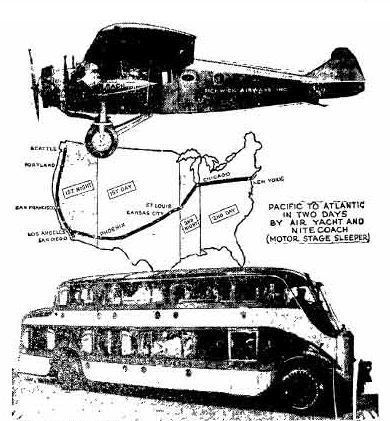The Success of the 1928 Nite Coach (on a Pierce Arrow chassis) prompted the introduction of a similar 53-passenger day coach, the Pickwick Duplex, in 1930. Austin did not rest on his laurels and in 1932 introduced a totally new Sleeper Coach which featured aerodynamic breadbox styling that wouldn’t appear on his competitor’s coaches until the late 1930s.
It is generally agreed that only four Nite Coaches were built (Carlton Jackson claims five), the first of which was christened the Alsacia after Alsacia M. Wren, one of Charles F. Wren's two daughters. The Alsacia had an unusual flat rear roof over the rear-most first floor cabin, a feature not found on subsequent Nite Coaches which all featured a fastback rear roof with an enclosed luggage compartment.
The next Nite Coach built, the Gladys, was named after Gladys I. Wren, Charles F. Wren's second daughter. The third coach constructed was christened the Morpheus, after the Greek god of dreams and sleep, while the name of the fourth and final first series Nite Coach has been lost to history.
What is known is that at least eighteen of the bread-box-style Nite Coaches were constructed. Ten were purchased by the Pacific Greyhound Line while the remaining eight coaches were sold to the Wren's Columbia Pacific Nite Coach Line. Whether they were constructed by Pickwick Motor Coach Works or by Columbia Coach Works remains unclear. At least one photograph gives a late 1932 date, although most state 1933 or later. Pictures exist of the coach in four liveries, Columbia Pacific Nite Coach Lines, Pacific Greyhound Line, Sante Fe Trail System Nite Coach and Santa Fe Trailways Sleeper Coach.
Columbia Pacific went bankrupt in 1935 and the route was taken over by the Burlington Line. The new owners elected to replace the two-year-old coaches with more cost-effective units so they were sold to the recently established Sante Fe Trailways Stage Line, who refurbished them for use on its daily Kansas City to Los Angles run.
Bus collector Eric McLain is the last recorded owner of the only Pickwick coach known to exist, a 1930 Duplex. Luckily a number of firms produced scale models based on the Nite Coach that are occasionally offered for sale.
above, in the lower right hand corner, the photo was annotated "Irish Hills Southern Mich"
what Woodlite headlights were: http://justacarguy.blogspot.com/2012/05/wood-lite-headlites-dim-and-useless-but.html
Of course, you knew that, cause you've been looking at the posts about them that I've had here, because I appreciate their design. Everything I've read says they were terrible at actually lighting the area in front of a vehicle, but... well, they look great!
the photos and drawing I found at the Motor Transport Museum, and what a find! "Any and all photos taken on the museums property must include the wording: "By permission of the Motor Transport Museum, 31949 Highway 94, Campo, California, web site: http://www.motortransportmuseum.org"
Everything there is to learn about these, and all the below images are at http://www.coachbuilt.com/bui/p/pickwick/pickwick.htm
Below info from http://www.nomadicista.org/viewtopic.php?f=4&t=1018
Quite possibly the oddest buses ever made in the United States were two "observation buffet" cars constructed in the Los Angeles shops of Pickwick Stages in 1928. Named "Cherokee" and "Crow", they featured a tiny kitchen squeezed beneath a raised observation deck and a "conning tower" for the driver,
One of these buses is shown on it's assigned route between Los Angeles and San Francisco, where raised seats afforded views of spectacular scenery.
The original design of Pickwick "Nite Coaches", of which only five were built, is represented here by "Morpheus".
Two Nite Coaches ran between St. Louis and Kansas City for Pickwick-Greyhound Lines for about six months in 1930 until they were ordered off the road as not meeting the size and weight limits of the Public Service Commission of Missouri. They reappeared later in San Francisco-Portland service.
"Morpheus" is pictured next to a Tri-Motor of Western Air Express, one of the predecessors of TWA. Not a Pullman car, but a bus: a compartment in a Nite Coach made up for overnight travel. Early bus lines, like early air lines, avoided night-time travel, and the Nite Coach was one effort to offer more effective competition to the railroads. The idea was periodically revived in the 1930's, but always foundered on the high operating cost because of the small number of overnight passengers that could be accommodated within legal size limits.
One of the original four Pickwick Nite Coaches at a scenic overlook in Yosemite National Park. Not on the regular route, the park was a popular attraction for charter parties and tour groups.
Buses built by Pickwick, Pioneer, Fageol and Yellow Coach are all visible in this 1934 view of Greyhound's San Francisco shop. The big power plant in the foreground with the instrument panel up high and almost over the radiator, is a six-cylinder Sterling "Petrel", the type of engine used in the original Pickwick Nite Coaches and Duplex day coaches. (I guess this explains why the engine on the model of the Nite Coach slides out the front, the engine and transmission were mounted on a sub frame that was removeable)
All text from Over The Road, A History of Intercity Bus Transportation in the United States by Albert Meier and John P. Hoschek, published by the Motor Bus Society, 1975



























0 comments:
Posting Komentar